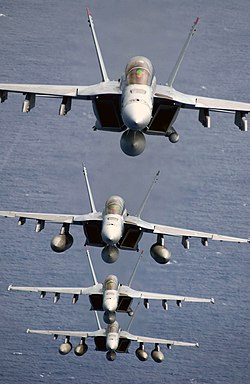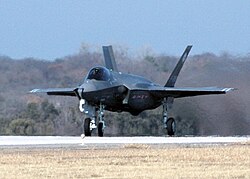ABC TV Documentary on Australian F18
 Last night (8:30pm, 29 October 2007) the Australian Broadcasting Corporation ran a program "Flying Blind" critical of the decision for Australia to buy F/A-18F Super Hornets as an interim replacement for the F111. It is also critical of the decision to buy the F-35 JSF:
Last night (8:30pm, 29 October 2007) the Australian Broadcasting Corporation ran a program "Flying Blind" critical of the decision for Australia to buy F/A-18F Super Hornets as an interim replacement for the F111. It is also critical of the decision to buy the F-35 JSF:For more than 30 years Australia has rested its security on the seemingly ageless wings of its F-111 fighter fleet.
But in aviation circles these days there are doubts and rumblings. Some experts fear Australia is set to give away its crucial air superiority in the region.
The reason, they claim, is that decision-makers have made the wrong choices about the planes that will replace the F-111s.
From: "Flying Blind"? Four Corners, 8.30 pm Monday 29 October.
Available from the ABC are:
The program seemed a little one sided, with a few people interviewed at length on the F-18's faults and only a few small segments on its strengths. Also the program seemed to mix up the roles of smaller fighter aircraft, such as the Dassault Rafale and Eurofighter Typhoon larger aircraft such as the Sukhoi Su-30/35/37 'Flanker'.
There was also some confusion over "generations" of aircraft. The Wikipedia entry for "Fighter Aircraft" describes the Rafale, Typhoon, 'Flanker' and the Super Hornet as "Generation 4.5 (1990-2000)", which seems reasonable. The F/A-18 Hornet is described as Fourth generation (1970-1990). The F-111 is not listed as it is a medium-range strategic bomber, reconnaissance, and tactical strike aircraft not a fighter.
Also the program seemed to miss the point that the Super Hornets were more stealthily than the F-18, plus have a very advanced radar and electronics, similar to that of the F-35. The Super Hornets are intended to operate in concert with each other, sharing data and with the Boeing Wedgetail Airborne Early Warning & Control (AEW&C) aircraft. It should even be possible to share data with troops on the ground by podcast for Network Centric Warfare.
The program seemed to alternate between criticism of the Super Hornets for being outdated and the F-35 for being not yet available. Given the choices currently available to the Australian Government, it seems to me to be reasonable to buy something proven to work now (Super Hornets) and keep the option to buy something better later, if it works (F-35). It is likely that the Super Hornet will work so well that Australia will skip the F-35 and instead buy UAVs later, along with converted civilian airliners.
Other options
It should also be noted that on 20 July the Australian Minister for Defense announced that Australia will spend $4B on the P-8A Poseidon Maritime Patrol and Response Aircraft (MPRA) to replace the AP-3C Orion. The MPRA is a modified Boeing 737 airliner, but it can carry about the weight of weapons as an F-111 and has a longer range. While not suitable for use in contested airspace, it would be useful for asymmetric warfare.
 It is likely the aircraft will also be used for electronic surveillance and signals interception (SIGINT and ELINT). The aircraft have a lot of room, compared to the typical military aircraft, to carry rack mounted supercomputers for real time processing of signals and to act as a flying web server to distribute information to other aircraft, ships and vehicles.
It is likely the aircraft will also be used for electronic surveillance and signals interception (SIGINT and ELINT). The aircraft have a lot of room, compared to the typical military aircraft, to carry rack mounted supercomputers for real time processing of signals and to act as a flying web server to distribute information to other aircraft, ships and vehicles.Mix of F/A-18F Super Hornets, UAVs and Carrier F-35s for Australia?
The Australian government's decision to buy the F/A-18F Super Hornet fighter/attack aircraft seems a reasonable one. The Super Hornet is a two seat derivative of the F/A-18 Hornet currently in service with the RAAF.
The Super Hornet would be used as a stop gap due to a delay in the availability of the F-35 Lightning II Joint Strike Fighter. These are to replace the F111s due for retirement in 2010.
The F/A-18F is relatively new design, has the advantage of being proven in service but is not a stealth aircraft like the F-35. While the Australian plan seems to be to only order enough Super Hornets as a temporary stopgap, it may make sense to retain them to replace the older F/A-18s. Australian could then consider if F-35s are needed, or if their job could be better done with UAVs exploiting advanced computers and telecommunications technology.
 Lockheed Martin have proposed an UAV derivative of the F-35, with a typical mission consisting of four unmanned JSFs controlled from two piloted F-35 or F-22s. Sensor information would be shared between the aircraft via datalinks. However, the F-35 and F-22 are both single seat aircraft, leaving the pilot little time to fly another two aircraft remotely. In contrast the F/A-18F has two seats, making it more feasible for one of the crew to control the UAVs.
Lockheed Martin have proposed an UAV derivative of the F-35, with a typical mission consisting of four unmanned JSFs controlled from two piloted F-35 or F-22s. Sensor information would be shared between the aircraft via datalinks. However, the F-35 and F-22 are both single seat aircraft, leaving the pilot little time to fly another two aircraft remotely. In contrast the F/A-18F has two seats, making it more feasible for one of the crew to control the UAVs. Australia could also consider a mix of land based F/A-18Fs and F-35B Short Take-Off Vertical Landing (STOVL) aircraft based on the new Landing Helicopter Dock (LHD) ships, which are essentially small aircraft carriers. The F-35B stealth capabilities would complement the longer range of the F/A-18F.
Australia could also consider a mix of land based F/A-18Fs and F-35B Short Take-Off Vertical Landing (STOVL) aircraft based on the new Landing Helicopter Dock (LHD) ships, which are essentially small aircraft carriers. The F-35B stealth capabilities would complement the longer range of the F/A-18F.See also books on:
- Military Technology
- UAVs
- F-35 Joint Strike Fighter Program
- Network Centric Warfare
- airborne early warning and control aircraft
Labels: Defence IT, f-35, F/A-18F Super Hornet, Network Centric Warfare

















